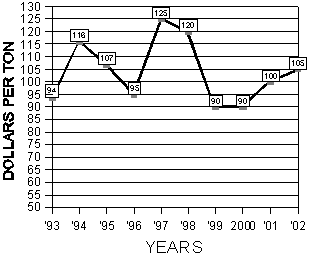Alfalfa Report
Yuma County, Arizona
January 28, 2002
Yuma County Office
2200 W. 28th Street, Ste. 102
Yuma, AZ 85364
(928) 726-3904
(928) 726-8472 FAX
Production Update:
PDF version, 62KB
Hay Preservatives (Part 1) Hay preservatives allow hay to be baled at moisture contents ranging from 25 to 30% without damage from heat and mold. The advantage of baling at a higher moisture content, of course, is to lessen harvesting and storage losses, decrease the chance of rain damage, extend the period during the day when baling is possible, and improve hay quality. Hay preservatives are normally applied with the baler. Preservatives are most economical when they allow rain damage to be avoided.
Insect Management: Egyptian alfalfa weevil populations are building in hay fields. The first management step is to sample alfalfa fields every 2 to 4 days after weevil larvae first appear. Sample each field quadrant by taking 5 sweeps with a standard net. Count the number of weevil larvae in each 5 sweep sample and add the totals for each of the field quadrants. Divide the grand total for the field by the total number of sweeps (20). The field should be treated with an insecticide registered for weevil control when to average number of larvae reaches of exceeds 20 per sweep. If sweep counts are 10 to 15 larvae per sweep just before cutting, then applying malathion under the windrows may be considered.
Weed Control: In addition to the 12 herbicides that are registered
and used to varying degrees in Arizona, there are at least a few more
that are being evaluated or registered. These include Raptor, Visor and
Sandea. There are more
herbicides registered on alfalfa than on many crops grown in Arizona.
| Market Summary |
High
|
Low
|
Average
|
Off grade
|
| Past 2 Weeks (Jan 15, 2002 - Jan 27, 2002) |
115
|
100
|
105
|
90-100
|
| Last Year (Jan 15, 2002 - Jan 27, 2002) |
105
|
95
|
100
|
70-90
|
10 Year Summary (Jan 15 - Jan 27, 1993-2002):

Issued in furtherance of Cooperative Extension work, acts of May 8 and June 30, 1914, in cooperation with the U.S. Department of Agriculture, James A. Christenson, Director Cooperative Extension, College of Agriculture and Life Sciences, The University of Arizona.
The University of Arizona is an equal opportunity, affirmative action institution. The University does not discriminate on the basis of race, color, religion, sex, national origin, age, disability, veteran status, or sexual orientation in its programs and activities.
Any products, services, or organizations that are
mentioned, shown, or indirectly implied in this web document do not imply
endorsement by The University of Arizona.
Information provided by:
Barry Tickes, btickes@ag.arizona.edu Extension Agent, Yuma County
Michael Ottman, mottman@ag.arizona.edu Agronomy Specialist
College of Agriculture, The University of Arizona.
Eric Natwick, etnatwick@ucdavis.edu UCCE Imperial County - Farm Advisor
University of California, Davis, CA.
Forages: Crop Mgmt | Soil Mgmt | Irrigation | Alfalfa Reports | Insects | Diseases | Weeds | Pesticides
Home | Other Crops | Forages
For more Arizona Production Ag Information:
Home | Cotton | Veggies| Forages | Grains | Citrus | Crop x Crop | Insects | Diseases| Weeds | Pesticides | News | Weather | Research | Photos | Contacts | General Info. | Site Map
Copyright © 2001 University of Arizona,
College of Agriculture and Life Sciences
Webmaster: Al Fournier (fournier@ag.arizona.edu)